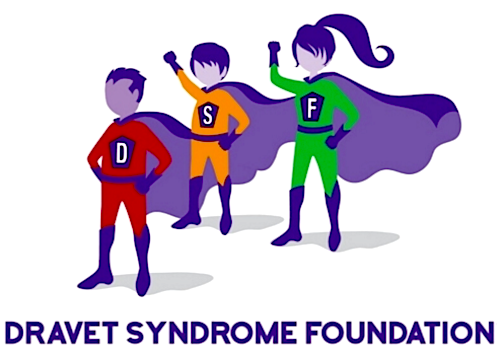|
|
Developmental Biology - Dravet Syndrome
New Therapy to Prevent Onset of Dravet Syndrome?
A promising new therapy alters the destructive course of this deadly disease - in mice...
There is a new development that may offer future hope to families with Dravet syndrome, a debilitating genetic disease causing intractable seizures — and possible sudden death.
Dravet syndrome and its variants, decrease the level of a crucial protein normal brain cells use to control the flow of sodium ions into cells.
Neurons need sodium channels to transmit signals back and forth to each other.
Patients with Dravet syndrome have variations in the sodium channel gene SCN1A, that generally result in there being only half the amount of the corresponding functional protein, Nav1.1, being made to function (expressed) in the brain.
"With only 50 percent SCN1A expression in the brain, you have a severe epileptic disease with a high risk of sudden death."
Lori L. Isom PhD, Professor of Molecular & Integrative Physiology and Neurology and Chair of the Department of Pharmacology, Department of Pharmacology, University of Michigan, Ann Arbor, Michigan, USA.
The research team's goal was to increase SCN1A gene expression back to 100 percent in neurons, by using an antisense oligonucleotide (ASO) developed by Stoke Therapeutics, a biotechnology company collaborating with Dr. Isom and her team. Together they tested the ASO called STK-001 in a Dravet syndrome mouse model. Unlike using CRISPR, viruses, or other forms of gene editing, ASOs are reversible.
"The brain normally uses sections of genes called poison exons to dial up or dial down the expression of a particular gene, as an internal regulatory mechanism. We are taking advantage of a poison exon in SCN1A to increase its expression [function].
The problem with gene therapy is you are changing something forever, which is risky especially with the brain. If you make a mistake, there's no going back."
Lori L. Isom PhD
Two days after the mice were born, researchers injected the STK-001 into the brains of mice carrying only one healthy copy of the SCN1A gene. The procedure led to a 97 percent survival for up to 90 days. Just 23% of untreated mice pups survived over the same period.
"Our thought is that early intervention with an ASO in mice may be able to change brain excitability," says Isom, "And if that's also true for kids with Dravet...that would be incredible." The results are published in the journal Science Translational Medicine.
Based on the encouraging findings of the mouse study, Stoke has recently launched a clinical study to begin evaluating STK-001 in children and adolescents with Dravet syndrome.
Isom notes that the mouse study could have even wider implications for treating the genetic cause of generalized epilepsy, especially for the third of patients whose epilepsy is not controlled with traditional drugs.
"We need to start over and think about epilepsy in a new light — to get at the genetic source, rather than being reactive and trying to treat something that has already happened."
Lori Isom PhD
Abstract
Dravet syndrome (DS) is an intractable developmental and epileptic encephalopathy caused largely by de novo variants in the SCN1A gene, resulting in haploinsufficiency of the voltage-gated sodium channel å subunit NaV1.1. Here, we used Targeted Augmentation of Nuclear Gene Output (TANGO) technology, which modulates naturally occurring, nonproductive splicing events to increase target gene and protein expression and ameliorate disease phenotype in a mouse model. We identified antisense oligonucleotides (ASOs) that specifically increase the expression of productive Scn1a transcript in human cell lines, as well as in mouse brain. We show that a single intracerebroventricular dose of a lead ASO at postnatal day 2 or 14 reduced the incidence of electrographic seizures and sudden unexpected death in epilepsy (SUDEP) in the F1:129S-Scn1a+/- × C57BL/6J mouse model of DS. Increased expression of productive Scn1a transcript and NaV1.1 protein was confirmed in brains of treated mice. Our results suggest that TANGO may provide a unique, gene-specific approach for the treatment of DS.
Authors
Zhou Han, Chunling Chen, Anne Christiansen, Sophina Ji, Qian Lin, Charles Anumonwo, Chante Liu, Steven C. Leiser, Meena, Isabel Aznarez, Gene Liau and Lori L. Isom.
Acknowledgements
Zhou Han1, Chunling Chen2, Anne Christiansen1, Sophina Ji1, Qian Lin1, Charles Anumonwo2, Chante Liu2, Steven C. Leiser3, Meena1, Isabel Aznarez1, Gene Liau1 and Lori L. Isom2,*
1 Stoke Therapeutics Inc., Bedford, MA 01730, USA.
2 Department of Pharmacology, University of Michigan, Ann Arbor, MI 48109, USA.
3 PsychoGenics Inc., Paramus, NJ 07652, USA.
Return to top of page.
| |
|
Aug 31 2020 Fetal Timeline Maternal Timeline News
 Dravet syndrome, also known as Severe Myoclonic Epilepsy of Infancy (SMEI), is a rare and catastrophic form of intractable epilepsy that begins in infancy, with an estimated incidence rate of 1:16,000 to 1:21,000 CREDIT Dravet Syndrome Foundation.
|



